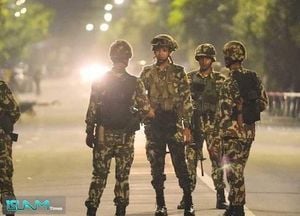On the morning of October 6, 2025, Governor JB Pritzker stood before a crowd of reporters at his Chicago office, the city’s skyline looming behind him. The topic at hand was nothing new: the federal government’s ongoing deployment of National Guard troops to Chicago and the broader implications for the city’s residents. But this time, the stakes felt higher, the rhetoric sharper, and the lines between federal and state authority blurrier than ever.
Just days prior, the Trump administration had moved to deploy National Guard troops to Illinois’ largest city, invoking a provision of federal law that allows such activation without the governor’s consent. According to Chicago Tribune reporting, the White House’s stated mission was to protect federal immigration enforcement agents and property—particularly as protests and confrontations at ICE facilities in the Chicago area had intensified. Yet, on national television, President Donald Trump and Vice President JD Vance repeatedly framed the deployment as a necessary response to violent crime and lawlessness in Chicago, a city they argued had been “given over to lawlessness and gangs for too long.”
Appearing on ABC’s This Week on October 12, Governor Pritzker pushed back forcefully. “They’re claiming in court that this is about protecting (U.S. Immigration and Customs Enforcement) facilities and ICE agents and not about crime on the streets,” he told host George Stephanopoulos. “But then you hear Vice President Vance and the president of the United States contravening that and saying exactly what they actually think. They just want troops on the ground because they want to militarize, especially blue cities and blue states.”
Vice President Vance, who appeared on the same program just before Pritzker, doubled down on the administration’s tough-on-crime message. “If you look at the murder rates in Chicago, the violent crime rates, you have women who have young families, they’re terrified their kids are going to get killed in a drive-by shooting. We have accepted this for far too long in the United States of America in some of our biggest cities, and Chicago unfortunately is the worst,” Vance said. “Why shouldn’t federal troops empower the people in Chicago to live safe lives when the governor and the local mayor just simply refuse to do their job?”
The numbers, however, tell a more nuanced story. Chicago, while leading the nation in the sheer number of homicides due to its size, does not have the highest homicide rate. In fact, official Chicago police statistics showed that as of October 5, 2025, the city had recorded 331 homicides—a staggering number, but one that represents a 49% decrease from the same period in 2021, during the height of the COVID-19 pandemic. Total shootings were also down 57% over the same four-year period, according to Chicago Tribune.
Despite these declines, the Trump administration pressed forward, arguing in court and Pentagon memos that the National Guard was needed due to threats and violence against federal agents enforcing immigration law. U.S. Defense Secretary Pete Hegseth’s memos, issued the previous weekend, made no mention of fighting general crime in Chicago. Instead, they stated that 300 Illinois National Guard troops would be used “to protect Federal property, at locations where violent demonstrations against these functions are occurring or are likely to occur based on current threat assessments and planned operations.”
The legal battle over the deployment escalated quickly. On October 6, U.S. District Judge April Perry, an appointee of President Joe Biden, issued a temporary restraining order blocking the deployment of Guard troops onto Chicago streets as part of the administration’s controversial immigration enforcement mission, dubbed “Operation Midway Blitz.” Perry’s ruling was unambiguous: she expressed skepticism about the government’s claims of out-of-control violence and argued that it was federal agents who had stoked tensions by using tear gas and militaristic tactics against protesters. “I have seen no credible evidence that there is a danger of a rebellion in the state of Illinois,” Perry wrote, deriding the Department of Justice’s explanations as “unreliable.”
The Trump administration immediately appealed, but on October 11, the 7th Circuit Court of Appeals denied their request for an emergency stay of Perry’s order. The court allowed the troops to remain federalized but prohibited them from engaging in any on-the-street activities for the time being.
In the background, the specter of the Insurrection Act loomed large. Trump has openly discussed invoking the centuries-old law—which serves as an exception to the Posse Comitatus Act, allowing the U.S. military to conduct domestic law enforcement in cases of rebellion or when enforcing federal law becomes impractical. The last time the Insurrection Act was used to suppress political demonstrations was during the 1992 Los Angeles riots, and Trump had previously considered invoking it during the 2020 George Floyd protests. Vice President Vance, speaking on NBC’s Meet the Press on October 12, confirmed that the administration was not ruling out the possibility. “The problem here is not the Insurrection Act or whether we actually invoke it or not. The problem is the fact that the entire media in this country, cheered on by a few far left lunatics, have made it OK to tee off on American law enforcement. We cannot accept that in the United States of America,” Vance said.
Pritzker, for his part, remained adamant that the legal threshold for invoking the Insurrection Act simply had not been met. “Well, the Insurrection Act is called the Insurrection Act for a reason. There has to be a rebellion, there has to be an insurrection in order for him to be allowed to invoke it,” Pritzker told Stephanopoulos. “He can say anything he wants, but if the Constitution means anything, and I guess we all are questioning that right now, but the courts will make the determination, (and) if the Constitution means anything, the Insurrection Act cannot be invoked to send them in because they want to fight crime.”
The political rhetoric surrounding the deployment has grown increasingly charged. Trump took to social media to call for the jailing of both Pritzker and Chicago Mayor Brandon Johnson for allegedly failing to protect ICE officers, a move that Pritzker described as part of a broader campaign to target political enemies. “They’re making things up to go after people. We’re seeing it day in and day out, and the fact that he’s made a threat against me, I’m not afraid. I’m going to stand up for the people of my state, and we’ve got to all stand together, because there (are) truly unconstitutional actions that are coming out of this administration, coming at the states and the people of the United States,” Pritzker declared.
Pressed by Stephanopoulos on whether he believed Pritzker had committed a crime, Vance declined to answer directly, saying instead, “He’s failed to do his job and should suffer some consequences. He’s violated his fundamental oath of office, which seems pretty criminal to me,” but ultimately deferred to the courts to decide.
The battle over federal intervention in Chicago is far from over, with the courts, state officials, and the White House locked in a tense standoff. For now, the city’s streets remain under local control, but the legal and political maneuvers unfolding could set precedents for how federal power is exercised in American cities for years to come.






